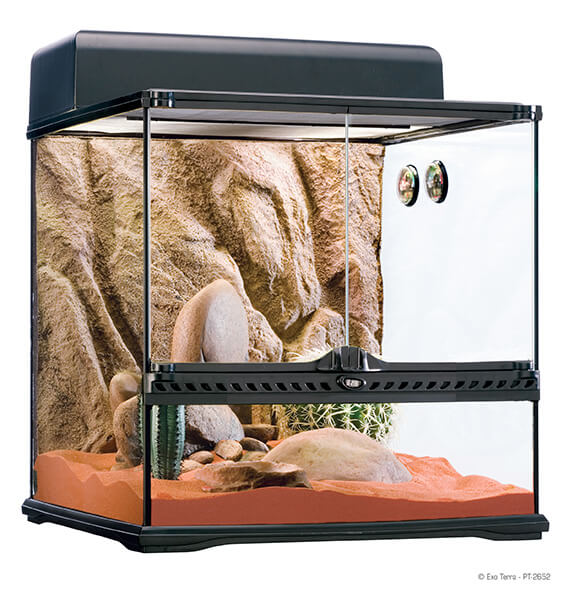Pet Lizard Habitats: The Desert Terrarium
Table of Contents
In this type of terrarium — also called a dry terrarium — the stones are the most important element. With them you can construct natural-looking rocky terrains that offer plenty of display and hiding places for your lizards. The territorial behavior of the lizards makes it essential to structure the desert terrarium well. Often it is not possible to use living plants in the dry terrarium, so use a bunch of nonresinous driftwood or dried cholla cactus skeletons.

Decorations of Natural Stone
All kinds of sandstones and shales are recommended, since they can be worked easily and are found at most stonemasons. You can easily shape them the way you want with the help of a cold chisel. But be careful using this tool; always wear safety glasses!
It will look the most natural if you only use stones of the same kind and from the same place.
Large stone constructions must be placed directly on the terrarium floor. Putting them on the sand is not secure enough; the lizards can tunnel under them, tip them over, and be injured. The single stones must be stuck to one another, because the lizards can also cause them to tumble down. You can use silicone caulk for gluing; you'll find it in a hardware or electrical-supply store, where you will find clear silicone that is safe to use in aquariums.
If you want to cover the back and the side walls with natural stone, build up the stones us regularly as possible — be careful about structure and arrangement — so that it looks like a hill of rock debris. The stones may be cemented together with freshly mixed mortar.
The mortar may be tinted to help create a more natural appearance.
Artificial Stones
With a certain amount of handcrafting skill you can also shape deceptively real-looking stones out of fiberglass fabric bonded with epoxy or polyester resin. Caution: Follow the manufacturer's instructions for handling the materials exactly so that you achieve the desired firmness and, above all, avoid any health hazards.
It's best to try making a sample first, so that you can try out the right colors and the appropriate surface. For instance, the “stone” should not be shiny, so you'll want to dull the surface with powder or sand. In doing so you should be careful not to make it too rough; otherwise the lizards can injure their feet on it.
Water Containers
Lizards that can live in the dry terrarium don't as a rule need very large water baths. The amount of water necessary is small and is often found in a hollow in a stone, which you may work into it, if necessary.
Display Places
You should create display places for dominant lizards. On the other hand, the lower-ranking animals need hiding places where they can escape the dominant animals and not be constantly overwhelmed by them.
Display places can easily be created from stones and dry wood. Make sure that these are going to be easy to make “sunny” later; that is, that they will lie in the angle of the warming light beam.
For a hiding place you can use a cactus skeleton, which you may obtain in a pet shop. Otherwise you can lay a halved clay pipe on the sandy floor, being sure that its diameter is large enough. If you dampen the inside of such “caves” with a plant sprayer, your lizards will have cool, damp hiding places during the hot hours of the day and at night.
Whatever materials the caves or hiding places are made of, they must always be large enough so that a lizard won't become stuck inside and its hiding place become a prison. Also, the hiding places should be so arranged that they are accessible to you, or at the very least you can see into them.
Egg-Laying Places
Most eggs will be laid in the damp caves described above, for in nature such places provide both protection from hungry predators and the dampness necessary for the maturation (incubation) of the eggs. But you can also induce your lizards to lay eggs in a place you've prepared ahead of time. In that case, most of the floor of the terrarium is paved with brick or some other straight-sided stone and covered with a thin layer of sand, and the area planned for egg laying is left unpaved so that it has the depth necessary for burying the eggs. This area is filled with sand.
Planting Zones
If the terrarium has an area of at least 5.4 square feet (0.5 m^2), it can be planted. Enough space must be left so that the UV and heat lamps can be arranged so as not to burn the plants.
Using a glass strip or a fence of stones, you can mark off a sufficiently large planting zone on the floor so that the plants can be well watered without soaking the whole floor. The fences should be fastened to the floor and the walls with silicone caulk. Since you will need to change the plants once in a while, they should be potted and the pots buried. The “fences” should be high enough so that the pots can't be seen. Cover the ground between the plant pots with a stainless-steel wire screen (mesh gauge, depending on the size of the lizards, 0.12 to 0.4 inches [3 to 10 mm]) to keep the lizards from digging in the damp area, for many lizards love to find damp resting places at night.




Leave a Reply